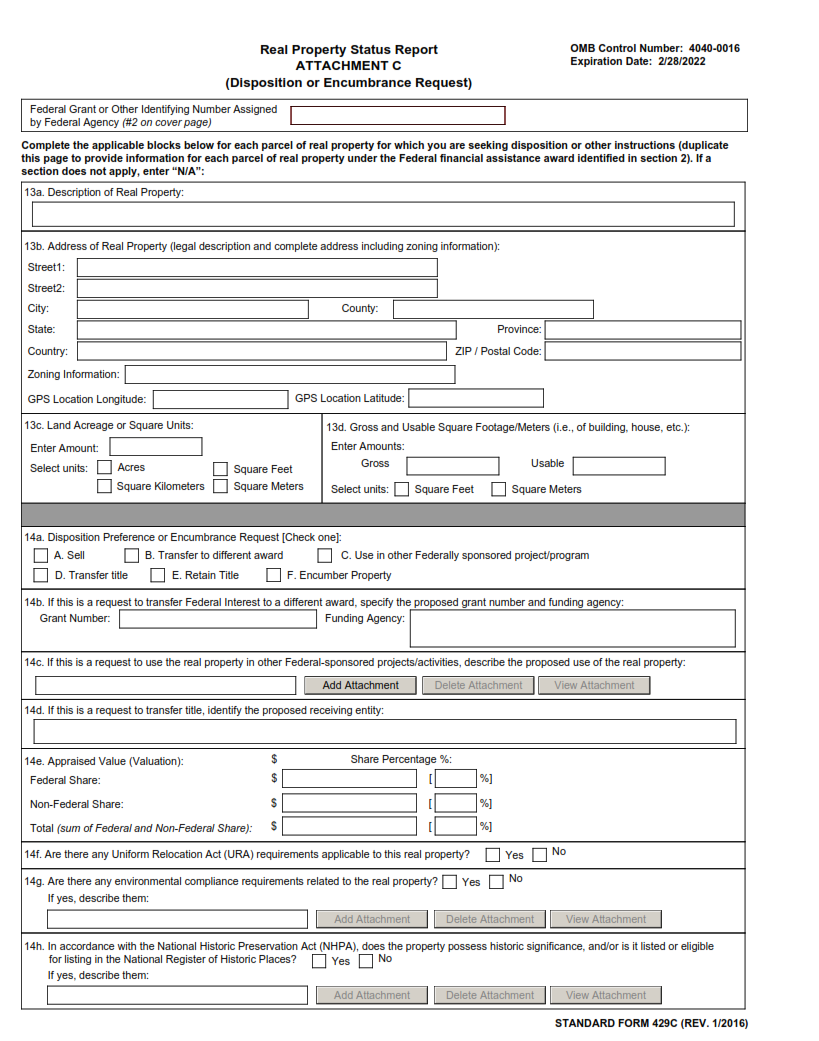SFFORMS.COM – SF 429C Form – Real Property Status Report – Attachment C – Disposition or Encumbrance Request – If you are a real estate investor or own property, you may come across the SF 429C Form – Real Property Status Report. This form is an important document used by government agencies to determine the status of federal real property and ensure that it is being properly managed.
Download SF 429C Form – Real Property Status Report – Attachment C – Disposition or Encumbrance Request
| Form Number | SF 429C Form |
| Form Title | Real Property Status Report – Attachment C – Disposition or Encumbrance Request |
| File Size | 2 MB |
| Date | 01/2016 |
What is an SF 429C Form?
The SF 429C form is a key document used by the Federal government for real property management. It is also referred to as the Real Property Status Report – Attachment C – Disposition or Encumbrance Request. The purpose of this form is to provide information on the current status of federal real estate assets and any encumbrances attached to them.
The SF 429C form contains detailed information about the ownership, use, and condition of government-owned properties. It must be completed whenever there are changes in property status such as transfer of ownership or when an asset has been declared surplus and needs to be sold. This report helps agencies identify which properties can be disposed of, what restrictions may apply, and how they should proceed with handling these assets.
In summary, the SF 429C form plays a critical role in managing federal real estate assets effectively. By providing accurate and up-to-date information about each property’s status, it enables agencies to make informed decisions about how best to manage their portfolios while adhering to applicable laws regulations governing disposal or encumbrance requests.
What is the Purpose of the SF 429C Form?
The SF 429C Form, also known as the Real Property Status Report, serves as a request for disposition or encumbrance of real property. This form is used by federal agencies to report on the status of their real estate assets and to initiate requests for action related to those assets. The information provided on this form includes details about the location, ownership, and condition of the property, as well as any proposed actions that may affect its use or value.
The purpose of the SF 429C Form is to ensure that federal agencies maintain accurate records of their real estate holdings and make informed decisions regarding their management. By requiring agencies to report on the status of their properties and obtain approval before disposing of or encumbering them in any way, this form helps prevent waste, fraud, and abuse in government operations. It also provides a mechanism for agencies to coordinate with each other and with other stakeholders involved in managing federal real estate assets.
Where Can I Find an SF 429C Form?
The SF 429C form is a crucial document in the real estate sector. It is used to provide information about the status of a property, including any dispositions or encumbrances on it. This form is required when buying or selling real estate, especially if it involves government-owned properties. If you are a buyer or seller of such property, you may wonder where to find an SF 429C form.
One sure way to find an SF 429C form is by visiting the General Service Administration (GSA) website. The GSA provides access to all federal forms used in various sectors, including real estate. You can download and print the form directly from their website for free. Alternatively, you can visit your local GSA office and collect a hard copy of the SF 429C form.
Another reliable source for obtaining an SF 429C form is by contacting your local Department of Veterans Affairs (VA). They have this document readily available as they deal with various federal programs that involve government-owned properties. By reaching out to them directly, they will guide you through the entire process and help ensure that everything runs smoothly regarding your dealings with government-owned properties that require filing an SF 429C Form.
SF 429C Form – Real Property Status Report – Attachment C – Disposition or Encumbrance Request
The SF 429C Form is a Real Property Status Report that provides information about the status of government-owned or leased real property. One of its attachments, Attachment C, serves as a Disposition or Encumbrance Request which is used by agencies to request permission for the sale, lease, transfer, exchange, or other disposition of government-owned real property. This attachment also outlines the process for obtaining approval and sets forth specific requirements that must be met before any disposition can take place.
The Disposition or Encumbrance Request requires detailed information about the property in question including location, size, condition and current use. It also requires a thorough analysis of market conditions and potential impacts on neighboring properties. In addition to outlining the proposed disposition plans in detail, agencies must also provide justifications for their actions based on economic feasibility and public interest considerations.
Overall, the SF 429C Form with its Attachment C provides an essential tool for government agencies to manage their real property assets effectively while ensuring compliance with all applicable laws and regulations governing dispositions. This report enables informed decisions related to buying, selling and leasing government-owned properties; it ensures transparency in these transactions while promoting efficient land use practices across federal lands.
SF 429C Form Example

